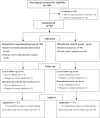Home-based telehealth exercise training program in Chinese patients with heart failure: A randomized controlled trial
- PMID: 30170422
- PMCID: PMC6392598
- DOI: 10.1097/MD.0000000000012069
Home-based telehealth exercise training program in Chinese patients with heart failure: A randomized controlled trial
Abstract
Background: Homed-based exercise training via telehealth is an effective method for cardiac rehabilitation in patients with heart failure (HF). However, little is known about the effects of telehealth exercise training among patients with HF in China.
Design: A randomized controlled design with repeated measures was adopted in this study.
Objective: To examine the effect of our telehealth exercise training program on health outcomes in patients with HF in China.
Methods: A total of 98 participants were randomly allocated to an experimental group (n = 49) and control group (n = 49) from January 2014 to February 2015 in a teaching hospital in Chengdu, People's Republic of China. Participants in the experimental group underwent an 8-week home-based telehealth exercise training program, including 32 exercise training sessions, with regular telephone or instant messaging follow-ups and consultations. Participants in the control group received usual care. The outcome variables used in this study were the Minnesota Living with Heart Failure Questionnaire, 6-minute walking distance (6MWD), resting heart rate (HR), Hospital Anxiety and Depression Scale, left ventricular ejection fraction (LVEF), and the New York Heart Association (NYHA) classification. Data were collected at baseline, post-test (2 months after discharge), and 4 months post-test (6 months after discharge). Repeated measures ANOVA was used to examine the effects of groups, changes over time, and interaction of time and group with the above variables.
Results: Statistically significant improvements were observed in the experimental group regarding quality of life (QOL) and 6MWD compared to the control group post-test. Significant improvements in QOL, 6MWD, and resting HR were sustained for 4 months post-test. However, no significant improvements were observed regarding the NYHA classification, LVEF, anxiety, and depression at either the post-test or 4-month post-test follow-ups. No patients experienced any significant complications or adverse outcomes during the program.
Conclusions: The results reveal that telehealth exercise training is an effective alternative method for cardiac rehabilitation, especially under the conditions in China.
Conflict of interest statement
The authors declare no conflicts of interest.
Figures

References
-
- Wang W, Zhu ML, Wang YJ, et al. Report on cardiovascular diseases in China. Chin Circulation J 2012;28:408–12.
-
- The Chinese society of Cardiology. Guidelines for the diagnosis and treatment of chronic heart failure. Chin J Cardiol 2007;35:1076–95.
-
- Tol BA, Huijsmans RJ, Kroon DW, et al. Effects of exercise training on cardiac performance, exercise capacity and quality of life in patients with heart failure: a meta-analysis. Eur J Heart Fail 2006;8:841–50. - PubMed
-
- Giannuzzi P, Temporelli PL, Corrà U, et al. Antiremodeling effect of long-term exercise training in patients with stable chronic heart failure results of the exercise in left ventricular dysfunction and chronic heart failure (ELVD-CHF) trial. Circulation 2003;108:554–9. - PubMed
Publication types
MeSH terms
LinkOut - more resources
Full Text Sources
Other Literature Sources
Medical
Research Materials
Miscellaneous

